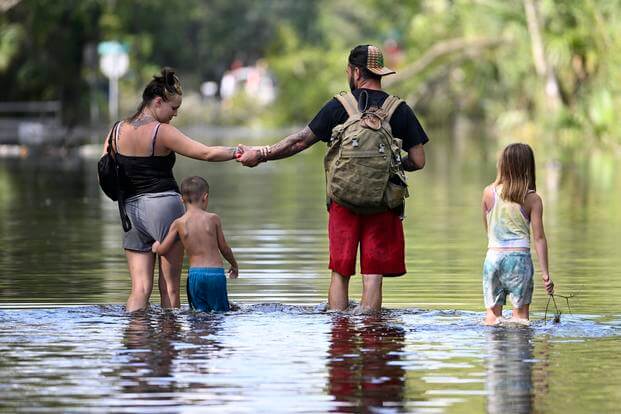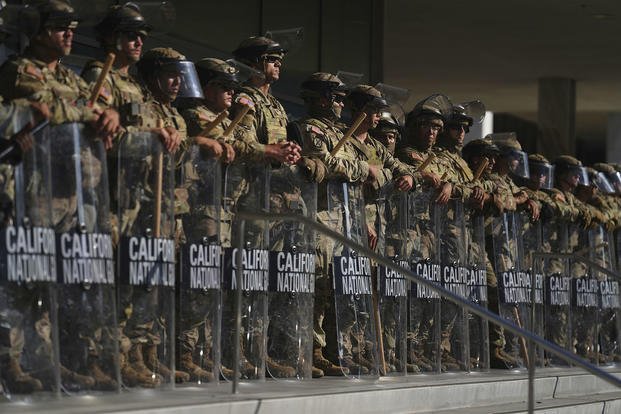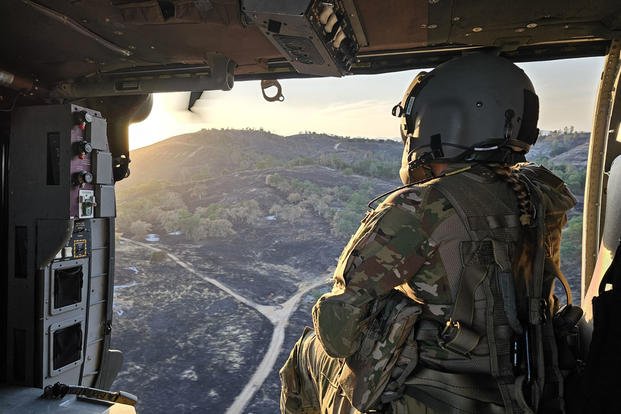Pentagon to Keep Sharing Key Satellite Data for Hurricane Forecasting Despite Planned Cutoff

The U.S. Department of Defense will now continue sharing key data collected by three weather satellites that help forecasters track hurricanes. Meteorologists and scientists had warned of risks to accurate and timely storm tracking without the information when officials made plans to stop providing it beyond the end of this month.
Defense officials had planned to cut off distribution of microwave data[1] from the Defense Meteorological Satellite Program, jointly run with the National Oceanic and Atmospheric Administration, by the end of June. At the time, NOAA said the cutoff was said “to mitigate a significant cybersecurity risk" while the U.S. Navy said the program didn't meet "information technology modernization requirements.” The discontinuation was postponed for one month[2].
In a notice on Wednesday, officials said there would be no interruption at all.
The Navy said in a statement that its Fleet Numerical Meteorology and Oceanography Center “had planned to phase out the data” as part of modernization efforts. "But after feedback from government partners, officials found a way to meet modernization goals while keeping the data flowing until the sensor fails or the program formally ends in September 2026.”
The data is used by scientists, researchers and forecasters, including meteorologists at the National Hurricane Center. It gives crucial information about storms that can’t be gleaned from conventional visible or infrared satellites.
“This satellite data enables hurricane forecasters and their computer models to peer inside a hurricane’s structure, offering vital insight," said Union of Concerned Scientists science fellow Marc Alessi. "Make no mistake: this data not only improves hurricane forecasting accuracy, but could make the difference between whether communities evacuate or not ahead of an approaching hurricane.”
Other microwave data would have been available with this cutoff, but only about half as much, experts said — increasing the chance that forecasters would miss certain aspects of storms.
A spokesperson for NOAA said the agency will continue to have access to the data for the program’s lifespan and noted that it is just one data set “in a robust suite of hurricane forecasting and modeling tools" that the National Weather Service has at its disposal to “ensure the gold-standard weather forecasting the American people deserve.”
The news had initially raised scientific eyebrows amid hurricane season[3], which usually peaks from mid-August to mid-October. Climate change, worsened by the burning of fossil fuels such as oil and coal, have driven storms to become more frequent, severe and deadly.
“The last-minute reprieve has hurricane forecasters breathing a sigh of relief,” said Jeff Masters, a meteorologist for Yale Climate Connections. “Loss of the microwave satellite data would have made it far more likely that timely warnings of dangerous and potentially deadly episodes of hurricane rapid intensification events being delayed by up to 12 hours.”
He added the restoration of the data is also good news for scientists tracking Arctic sea ice loss[4]. Images and microwave satellite data can estimate how much of the ocean is covered by ice, according to NOAA[5].
NOAA and the NWS have been the subject of several cuts throughout President Donald Trump's second term.
___
Alexa St. John is an Associated Press climate reporter.
___
The Associated Press’ climate and environmental coverage receives financial support from multiple private foundations. AP is solely responsible for all content. Find AP’s standards[6] for working with philanthropies, a list of supporters and funded coverage areas at AP.org[7].
© Copyright 2025 Associated Press. All rights reserved. This material may not be published, broadcast, rewritten or redistributed.
More Than 1,000 National Guard Troops Leaving LA. Newsom Says Trump's 'Political Theater Backfired'

Nearly two months after President Donald Trump took the extraordinary step of deploying the National Guard[1] to Los Angeles to quell public unrest over immigration raids, the Pentagon on Wednesday announced that it was withdrawing more than a thousand troops.
The departure of about 1,350 members of the National Guard, ordered by Defense Secretary Pete Hegseth, represents just the latest rollback of troops from L.A. this month since more than 5,000 National Guard members and Marines were deployed to the city in June.
Sean Parnell, chief spokesman for the Pentagon, said that approximately 250 California Guard members would remain in L.A. to protect federal agents and buildings.
"We greatly appreciate the support of the more than 5,000 Guardsmen and Marines who mobilized to Los Angeles to defend Federal functions against the rampant lawlessness occurring in the city," Parnell said in a statement.
Mayor Karen Bass, who had dubbed the deployment[2] an "armed occupation," was quick to celebrate the troops departure.
"Another win for Los Angeles," Bass said[3] on X Wednesday night. "We will continue this pressure until ALL troops are out of L.A."
The troops' presence in Los Angeles -- and their role of protecting federal agents conducting immigration raids -- was fiercely contested. President Trump said the troops were necessary to maintain order as the administration ramped up its immigration raids and protesters covered downtown buildings in graffiti, set Waymos on fire and clashed with Immigration and Customs Enforcement agents.
But many of California's key Democratic leaders said there was no need for federal troops in the city: local law enforcement could handle the protesters, they said, and the presence of federal troops in highly militarized gear only inflamed tension in the region. They also argued that federal officials had deployed the troops illegally.
Just a day after the first convoys of National Guard troops rumbled into L.A. on June 8, Gov. Gavin Newsom sued federal officials, saying that the deployment exceeded federal authority and violated the 10th amendment in an "unprecedented usurpation" of state power. Newsom also complained that the deployment had diverted the California National Guard from critical duties such as combating wildfires and interrupting the drug trade at the U.S.-Mexico border and across California.
His office released a statement responding to the latest draw down Thursday.
"President Trump is realizing that his political theater backfired. This militarization was always unnecessary and deeply unpopular," the statement said. "The President must do the right thing to end this illegal militarization now because the economic and societal impacts are dire. The women and men of our military deserve more than to be used as props in the federal government's propaganda machine."
Over the weeks, as the L.A. protests subsided, the troops did not appear to have a clear role and many appeared to be bored[4]. By July, a source within Newsom's office with knowledge of the military operation told The Times that only about 3% of the troops were taking part in daily missions.
"There's not much to do," one Marine told The Times as he stood guard earlier this month outside the Wilshire Federal Building in Westwood.
The majority of National Guard members were left largely milling about the Joint Forces Training Base in Los Alamitos in an operation that the Pentagon had estimated would cost about $134 million.
On July 15, the Pentagon withdrew nearly 2,000 California National Guard soldiers[5] from L.A. and on July 21 it withdrew 700 active-duty Marines[6].
© 2025 Los Angeles Times.
Visit latimes.com[7].
Distributed by Tribune Content Agency, LLC.[8]
© Copyright 2025 Los Angeles Times. All rights reserved. This material may not be published, broadcast, rewritten or redistributed.
The Army Reserve Is Gutting Aviation Units. Thousands of Soldiers Are Being Left in the Lurch.

Thousands of Army[1] Reserve soldiers are being forced to scramble for new assignments after the service abruptly ordered the dismantling of its helicopter units, a sweeping move that has caught commanders off guard and upended aviation operations across the country.
The cuts, which are set to eliminate all of the reserve's helicopter units by the end of the summer, are part of Army Chief of Staff Gen. Randy George's broader push to modernize the force by shedding legacy formations and redirecting resources toward emerging technologies such as drones and artificial intelligence.
But the transition has left troops questioning both the pace and planning of the changes. Military.com spoke with 16 Army Reserve aviators, including commanders and senior noncommissioned officers, who expressed frustration with what they described as a chaotic and poorly communicated rollout. All requested anonymity, citing concerns about retaliation, as they were not authorized to speak publicly.
Read Next: Air Force Rebrands Facebook Page to Combat Rumors, Leaked Memos and Reddit Threads[2]
"There was no heads-up, no briefing," said one senior noncommissioned officer. "Just an email saying aviation's going away and we need to find somewhere else to go."
News began trickling out within the aviation community's inner circle in February when Brig. Gen. Roger Deon, the head of Army Reserve Aviation Command, began meeting with commanders to give them a warning that the Pentagon had its sights on Army Reserve aviation for cuts, multiple senior officers with direct knowledge described.
The plan to cut all of the component's aviation didn't materialize until May, and that information took longer to reach the rank and file.
"That's whirlwind-fast for government work," one aviator noted, expressing frustrations with the rapid closure of units.
Some reserve aviation units are now working to find alternative roles for their pilots and full-time personnel, including potential placements with federal agencies such as U.S. Customs and Border Protection. Opportunities within the National Guard[3] or the active-duty Army are limited and often require relocation, adding another layer of complexity for service members and their families.
For junior enlisted soldiers and part-time reservists in support roles such as mechanics, crew chiefs and administrative staff, the road ahead is even more complicated. Transferring into a new unit or occupational specialty can take months of retraining, a process that can be especially burdensome for reservists balancing military obligations with full-time civilian jobs or college coursework.
"There was no time to plan," one senior reserve aviator told Military.com. "This was all put on us to just figure out; there's been no support on this."
It's unclear how many soldiers will be affected. Maj. William Allred, an Army Reserve spokesperson, declined to say, noting operational security. However, the number of soldiers in formations is routinely publicized information.
"While the soldiers in the Army Reserve Aviation Command will be impacted by the cuts, they will have the opportunity to continue their military service in other units where their skills can be utilized," Allred said in a statement to Military.com.
Army Reserve aviation as a whole includes about 4,600 soldiers, including some fixed-wing aircraft formations, though helicopter units make up the lion's share of the force, with units in California, Washington state, Texas, Kansas, Colorado, Florida, South Carolina, North Carolina, New Jersey and Kentucky.
Changing components isn't easy. Parts of National Guard service may also be less attractive to reservists, some of those soldiers explained. The reserve often compensates troops for travel and hotels during their weekend duty obligations, a perk that is absent in the National Guard -- much to the chagrin of reservists who have been interviewed and are looking to switch components.
And Guard service often carries heavier demands. The component is routinely tapped for both overseas deployments[4] and domestic missions, including disaster relief, border security and civil unrest response, duties that can sometimes be a greater burden on part-time soldiers compared to their reserve counterparts. Acquiring federal benefits is also more complicated.
The Army Reserve has not yet developed a comprehensive plan for soldiers to exit their contracts, but if they join the National Guard, they may also be required to repay generous enlistment bonuses of up to $20,000. The Army Reserve declined to comment on questions related to bonuses.
"We were told if we received a bonus, we'd have to pay it back," one enlisted soldier said.
Unlike their active-duty counterparts, reservists can't easily pivot to new units, particularly in large states or places with significant geographical gaps between units. Many people balance civilian jobs and family obligations, making relocation nearly impossible. Others have highly specialized skills -- such as air medical -- that are now disappearing.
Some units are scrambling to land spots in the National Guard, with upcoming weekend drills hosting recruiters[5], but that option comes with limited slots and often requires troops to sign new multi-year contracts.
"It's mostly been on our own accord, [to] find a new home, to figure it out," another soldier noted.
Meanwhile, lawmakers in both parties are growing increasingly frustrated with the Army's disjointed rollout of major force structure changes, criticizing what they see as a lack of transparency and strategic coherence.
While there's broad agreement on Capitol Hill that the service needs to modernize and move beyond a doctrinal framework that's remained largely unchanged for decades, many say the Army has failed to articulate its plans clearly.
Several Capitol Hill aides expressed concerns to Military.com that there is a perception reforms are being implemented in an ad hoc and overly hasty manner, leaving Congress in the dark.
One of the units on the chopping block is the 1st Assault Helicopter Battalion, 158th Aviation Regiment, a Texas-based formation with a record of responding to domestic emergencies, including relief efforts following Hurricane Harvey in 2017.
"You've come into my house, where I was born and raised, in this county, and you're taking something away from me, and I want to know why," Rep. Morgan Luttrell, R-Texas, told George and Army Secretary Dan Driscoll during a budget hearing last month.
Related: Decades of Troubles for Air Force Maintainers Set to Get Worse with Job Consolidation [6]
© Copyright 2025 Military.com. All rights reserved. This article may not be republished, rebroadcast, rewritten or otherwise distributed without written permission. To reprint or license this article or any content from Military.com, please submit your request here[7].